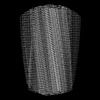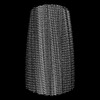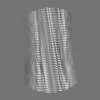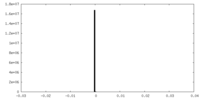+ Open data
Open data
- Basic information
Basic information
| Entry |  | ||||||||||||
|---|---|---|---|---|---|---|---|---|---|---|---|---|---|
| Title | Recombinant AD-fold Quadruple Helical Filament Polymorph | ||||||||||||
 Map data Map data | |||||||||||||
 Sample Sample |
| ||||||||||||
 Keywords Keywords | Recombinant Human Truncated Tau 287-391 200mM MgCl2 200 RPM 10mM PB DTT Condition 24a in original publication. / PROTEIN FIBRIL | ||||||||||||
| Biological species |  Homo sapiens (human) Homo sapiens (human) | ||||||||||||
| Method | helical reconstruction / cryo EM / Resolution: 3.32 Å | ||||||||||||
 Authors Authors | Vaquer-Alicea J / Diamond MI / Kunach P | ||||||||||||
| Funding support |  United States, 3 items United States, 3 items
| ||||||||||||
 Citation Citation |  Journal: Sci Adv / Year: 2025 Journal: Sci Adv / Year: 2025Title: Functional classification of tauopathy strains reveals the role of protofilament core residues. Authors: Jaime Vaquer-Alicea / Victor A Manon / Vaibhav Bommareddy / Peter Kunach / Ankit Gupta / Jim Monistrol / Valerie A Perez / Hung Tri Tran / Nil Saez-Calveras / Siling Du / Sushobhna Batra / ...Authors: Jaime Vaquer-Alicea / Victor A Manon / Vaibhav Bommareddy / Peter Kunach / Ankit Gupta / Jim Monistrol / Valerie A Perez / Hung Tri Tran / Nil Saez-Calveras / Siling Du / Sushobhna Batra / Daniel Stoddard / Charles L White / Lukasz A Joachimiak / Sarah H Shahmoradian / Marc I Diamond /  Abstract: Distinct tau amyloid assemblies underlie diverse tauopathies but defy rapid classification. Cell and animal experiments indicate tau functions as a prion, as different strains propagated in cells ...Distinct tau amyloid assemblies underlie diverse tauopathies but defy rapid classification. Cell and animal experiments indicate tau functions as a prion, as different strains propagated in cells cause unique, transmissible neuropathology after inoculation. Strain amplification requires compatibility of the monomer and amyloid template. We used cryo-electron microscopy to study one cell-based yellow fluorescent protein (YFP)-tagged strain, resolving its amyloid nature. We then used sequential alanine (Ala) substitution (scan) within tau repeat domain (RD) to measure incorporation to preexisting tau RD-YFP aggregates. This robustly discriminated strains, defining sequences critical for monomer incorporation. We then created 3R/4R or 4R wild-type RD (amino acids 246 to 408) biosensors. Ala scan of recombinant tau seeds with the Alzheimer's disease (AD) fold matched that of AD homogenate. We scanned 22 brain lysates comprising four tauopathies. This clustered cases by neuropathological syndrome, revealed the role of amino acids in protofilament folds, and allowed strain discrimination based on amino acid requirements for prion replication. | ||||||||||||
| History |
|
- Structure visualization
Structure visualization
| Supplemental images |
|---|
- Downloads & links
Downloads & links
-EMDB archive
| Map data |  emd_46915.map.gz emd_46915.map.gz | 40.3 MB |  EMDB map data format EMDB map data format | |
|---|---|---|---|---|
| Header (meta data) |  emd-46915-v30.xml emd-46915-v30.xml emd-46915.xml emd-46915.xml | 16.8 KB 16.8 KB | Display Display |  EMDB header EMDB header |
| FSC (resolution estimation) |  emd_46915_fsc.xml emd_46915_fsc.xml | 12.1 KB | Display |  FSC data file FSC data file |
| Images |  emd_46915.png emd_46915.png | 73.6 KB | ||
| Masks |  emd_46915_msk_1.map emd_46915_msk_1.map | 149.9 MB |  Mask map Mask map | |
| Filedesc metadata |  emd-46915.cif.gz emd-46915.cif.gz | 4.7 KB | ||
| Others |  emd_46915_additional_1.map.gz emd_46915_additional_1.map.gz emd_46915_half_map_1.map.gz emd_46915_half_map_1.map.gz emd_46915_half_map_2.map.gz emd_46915_half_map_2.map.gz | 4.1 MB 6.2 MB 6.2 MB | ||
| Archive directory |  http://ftp.pdbj.org/pub/emdb/structures/EMD-46915 http://ftp.pdbj.org/pub/emdb/structures/EMD-46915 ftp://ftp.pdbj.org/pub/emdb/structures/EMD-46915 ftp://ftp.pdbj.org/pub/emdb/structures/EMD-46915 | HTTPS FTP |
-Validation report
| Summary document |  emd_46915_validation.pdf.gz emd_46915_validation.pdf.gz | 666.7 KB | Display |  EMDB validaton report EMDB validaton report |
|---|---|---|---|---|
| Full document |  emd_46915_full_validation.pdf.gz emd_46915_full_validation.pdf.gz | 666.3 KB | Display | |
| Data in XML |  emd_46915_validation.xml.gz emd_46915_validation.xml.gz | 19.7 KB | Display | |
| Data in CIF |  emd_46915_validation.cif.gz emd_46915_validation.cif.gz | 26 KB | Display | |
| Arichive directory |  https://ftp.pdbj.org/pub/emdb/validation_reports/EMD-46915 https://ftp.pdbj.org/pub/emdb/validation_reports/EMD-46915 ftp://ftp.pdbj.org/pub/emdb/validation_reports/EMD-46915 ftp://ftp.pdbj.org/pub/emdb/validation_reports/EMD-46915 | HTTPS FTP |
-Related structure data
- Links
Links
| EMDB pages |  EMDB (EBI/PDBe) / EMDB (EBI/PDBe) /  EMDataResource EMDataResource |
|---|
- Map
Map
| File |  Download / File: emd_46915.map.gz / Format: CCP4 / Size: 149.9 MB / Type: IMAGE STORED AS FLOATING POINT NUMBER (4 BYTES) Download / File: emd_46915.map.gz / Format: CCP4 / Size: 149.9 MB / Type: IMAGE STORED AS FLOATING POINT NUMBER (4 BYTES) | ||||||||||||||||||||||||||||||||||||
|---|---|---|---|---|---|---|---|---|---|---|---|---|---|---|---|---|---|---|---|---|---|---|---|---|---|---|---|---|---|---|---|---|---|---|---|---|---|
| Projections & slices | Image control
Images are generated by Spider. | ||||||||||||||||||||||||||||||||||||
| Voxel size | X=Y=Z: 0.83 Å | ||||||||||||||||||||||||||||||||||||
| Density |
| ||||||||||||||||||||||||||||||||||||
| Symmetry | Space group: 1 | ||||||||||||||||||||||||||||||||||||
| Details | EMDB XML:
|
-Supplemental data
-Mask #1
| File |  emd_46915_msk_1.map emd_46915_msk_1.map | ||||||||||||
|---|---|---|---|---|---|---|---|---|---|---|---|---|---|
| Projections & Slices |
| ||||||||||||
| Density Histograms |
-Additional map: #1
| File | emd_46915_additional_1.map | ||||||||||||
|---|---|---|---|---|---|---|---|---|---|---|---|---|---|
| Projections & Slices |
| ||||||||||||
| Density Histograms |
-Half map: #1
| File | emd_46915_half_map_1.map | ||||||||||||
|---|---|---|---|---|---|---|---|---|---|---|---|---|---|
| Projections & Slices |
| ||||||||||||
| Density Histograms |
-Half map: #2
| File | emd_46915_half_map_2.map | ||||||||||||
|---|---|---|---|---|---|---|---|---|---|---|---|---|---|
| Projections & Slices |
| ||||||||||||
| Density Histograms |
- Sample components
Sample components
-Entire : Truncated tau 287-391
| Entire | Name: Truncated tau 287-391 |
|---|---|
| Components |
|
-Supramolecule #1: Truncated tau 287-391
| Supramolecule | Name: Truncated tau 287-391 / type: complex / ID: 1 / Parent: 0 |
|---|---|
| Source (natural) | Organism:  Homo sapiens (human) Homo sapiens (human) |
-Experimental details
-Structure determination
| Method | cryo EM |
|---|---|
 Processing Processing | helical reconstruction |
| Aggregation state | filament |
- Sample preparation
Sample preparation
| Concentration | 10 mg/mL |
|---|---|
| Buffer | pH: 7.4 / Details: 10mM Phosphate Buffer 10mM DTT 200mM MgCl2 |
| Grid | Model: Quantifoil R1.2/1.3 / Material: COPPER / Mesh: 300 / Pretreatment - Type: GLOW DISCHARGE |
| Vitrification | Cryogen name: ETHANE / Chamber humidity: 100 % / Chamber temperature: 293 K / Instrument: FEI VITROBOT MARK IV |
- Electron microscopy
Electron microscopy
| Microscope | FEI TITAN KRIOS |
|---|---|
| Specialist optics | Energy filter - Name: GIF Bioquantum / Energy filter - Slit width: 20 eV |
| Image recording | Film or detector model: GATAN K3 (6k x 4k) / Average electron dose: 57.0 e/Å2 |
| Electron beam | Acceleration voltage: 300 kV / Electron source:  FIELD EMISSION GUN FIELD EMISSION GUN |
| Electron optics | C2 aperture diameter: 50.0 µm / Illumination mode: FLOOD BEAM / Imaging mode: BRIGHT FIELD / Nominal defocus max: 2.2 µm / Nominal defocus min: 0.8 µm / Nominal magnification: 105000 |
| Experimental equipment |  Model: Titan Krios / Image courtesy: FEI Company |
 Movie
Movie Controller
Controller











 Z (Sec.)
Z (Sec.) Y (Row.)
Y (Row.) X (Col.)
X (Col.)





















































